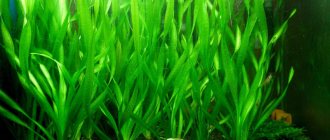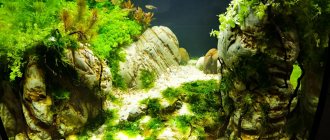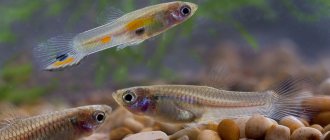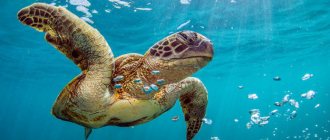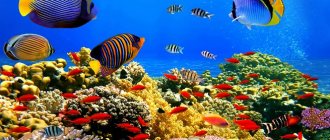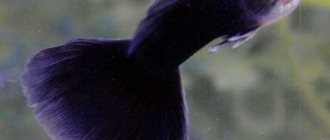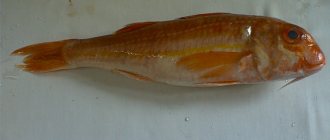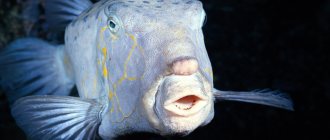The most popular aquarium fish - what is its secret
Guppy is a miniature fish belonging to the Poeciliidae family. An important feature of this variety of freshwater fish is the specificity of its reproduction. Most of the Petsiliev representatives are viviparous. This suggests that it is not caviar that emerges from the mother’s body, but a full-fledged fry.
Gender differences in guppies are obvious. Males of any species are always brighter and more elegant than females.
These aquarium inhabitants are characterized by striking sexual dimorphism, which implies differences in the appearance of individuals of different sexes. The dimensions of the female are 2 times larger than the dimensions of the partner and amount to 6 cm. In addition, female individuals have a less rich color than the male. The body of the fish is covered with diamond-shaped scales, which is their distinctive feature.
Guppies are one of the most common breeds of aquarium fish in our country, due to their ease of breeding and ease of maintenance. These babies are not demanding and absolutely easy to care for. In addition, there are a huge number of varieties of guppy fish that attract beginner aquarists with their diversity.
Guppy fish have also provided a great service to the world community. The fact is that guppies happily eat the larvae of malaria mosquitoes, and to combat these parasites, guppies were introduced into the reservoirs of many countries.
Even beginners can keep these small fish.
- the ideal temperature in the aquarium is 23-25°;
- hardness: dH 10-25°;
- acidity: pH 7.
They tolerate hard water well and gradually adapt to salinity, thanks to their innate natural endurance. It is important for fish that the water in the aquarium is clean and constantly replaced with fresh water. A small current is acceptable for them, which avoids stagnation of water. If you fail to provide the fish with the necessary conditions, then you risk losing your pets. Particular attention should be paid to the lighting fixtures of the aquarium. Light must be present for at least 10 hours , otherwise insufficient lighting can cause illness in pets.
08:15
Guppy. About maintenance, care and reproduction.
Guppies are omnivorous fish, so providing them with a balanced diet will not be difficult. Their daily diet should include food with elements of plant and animal origin. It is worth giving food to the fish 1-2 times a day in small portions.
It is important to avoid overfeeding aquarium pets. To do this, it is worth giving the fish a fasting day, when you shouldn’t feed them at all. This will help keep your pets healthy and increase their life expectancy.
Maintenance and care
Guppies are absolutely not capricious fish. Even a beginner can handle caring for them. The guppy aquarium is suitable for any size. In some cases, they can even live in a jar, but in such conditions they will not grow even to medium size. In order for the fish to move comfortably in the aquarium, there must be at least 1.5 liters of water per fish.
The determining factor for a baby's long life is the quality of the water in the aquarium. It must be clean, and its temperature must be about 20-26 degrees. The best pH value for these fish is 7.
Also don't forget about plants, filtration and lighting. Gupeshki love to have ferns growing in their aquarium - it resembles their natural habitat.
If the fish do not have enough air, then they constantly stay in the upper layers of the water - that is why guppies swim on the surface. Although the guppies themselves like to stay in the upper layers. Don't panic right away if they float near the surface of the water.
It is best to keep guppies in a small group - a couple of fish will not look particularly good. They can get along well with different types of fish due to their peaceful nature. But the guppies themselves are often offended by large and predatory fish, which take them for food. They often tear their tails, which can cause babies to die quickly. Therefore, it is very important to know which fish can be kept with them.
Guppies can get along with almost all small fish: congo, rasboras, cardinals, cockroaches, speckled catfish. You can also keep cherry barbs together with guppies - these are, perhaps, the main species with which the fish get along. But with swordfish, pangasius, gouramis, barbs, thorns, these little ones should not be planted in the aquarium.
Classification of species
To date, aquarists have studied a large number of species and breeds of this popular fish. At the same time, breeders never cease to amaze with the variety of new groups of guppies that have been bred. This aquarium pet has long become a regular at international exhibitions and competitions, thanks to its many shapes and colors. Modern species of guppies include more than a hundred breeds and breeding groups of representatives of the Peciliaceae. Fish are classified by color and type of caudal fin. Also, the natural forms of these fish are classified into a separate group.
Natural types of guppies
There are 3 main types of in nature .
Ordinary
This is the most common species of guppy in the world from which all other morphs originate. It’s not for nothing that more than 60 breeds of these miniature fish have been identified. The appearance of this variety of guppies is much simpler than that of their purebred counterparts. The fish, about 3-6 cm in size (depending on gender), has a slightly rounded tail and multi-colored spots on the body.
Endler
These fish are even more modest in size. The maximum length of the male is only 2.5 cm. The size of his partner can reach 3.5 centimeters. Females look discreet, while male Endler guppies are full of yellowish, purple, green and black colors.
Micropecilium
The Swamp Pict (Micropecilius) is a larger variety of guppy that is extremely rare . The size of this fish can reach 5 cm. Females are inconspicuous, and males are not deprived of bright external characteristics. There are many color options: from gray to bright orange. Their mouth has a sharper shape, and some of them are characterized by bright stripes on the side.
Diseases
Guppy diseases have certain symptoms, and after the diagnosis is determined, treatment is prescribed. If there is no help, the fish often die.
If a guppy's eyes have turned black, then this is a reason to pay attention to the fish. It happens that this external symptom means absolutely nothing, but sometimes it manifests itself due to a change in conditions of detention. It sometimes appears in females after childbirth.
But black eyes can be a sign of mycobacteriosis. The fish is treated with tetracycline baths (0.2 g per 10 l), and the aquarium is treated with kanamycin (1 g per 30 l). Without treatment, guppies will quickly die.
If the guppy lies on the bottom, this may be a sign of ichthyosporidosis or oodinosis. But the second is also characterized by the presence of a yellowish or brownish coating on the scales. The disease is successfully treated, and adults rarely die from it. It is worth remembering that a fish may lie on the bottom due to overeating or a change in living conditions.
Ichthyophthiriasis or semolina is one of the most common diseases in fish, but guppies rarely suffer from it. Symptoms – the fish seems to be sprinkled with semolina, swims near the surface, rubs against the plants. If left untreated, the fish goes blind and the fins begin to tear. In the end, babies often die.
Treatment: the fish are placed in an aquarium without algae and soil, and treated with bicillin-5. The causative agents of the disease die without carrier fish after 2-3 days - thus, the main aquarium is cleaned.
Types of guppies by color
The most popular classification of guppies is by color. All fish are colored. A huge variety of breeds have been developed with different shades and colors. Only experienced aquarists can remember the types and names of fish. But after studying the basic characteristics of the species, even a beginner will be able to see the differences.
Yellow
Yellow carpet
Bright fish with a beautiful “carpet” color.
Germanic
Yellow fish with white spots. Germans also come with a white body.
Golden (golden)
The color of the body of this variety of guppy is actually yellowish, but the scales in the light shimmer beautifully with a golden hue.
Yellowish blond
Very bright yellow color. White spots are also observed on the body.
Reds
Red Moscow
The fish is a beautiful scarlet color. In front, the guppy's belly and face are lighter in color.
Red blond
This type of guppy has a rich red color. Depending on gender, they may have white, blue and orange dots.
Royal
The fish is also called the red dragon. The appearance of these fish is impressive: intense red color with slight darkening closer to the tail.
Red clove
The fish has a bright scarlet color. Most often they are classified as skirt hair (according to the shape of the tail).
Filigree
The body of the fish has a silvery tint. The tail fin has a bright pattern that looks like snake skin.
Neon
Guppy blue neon.
These fish have the most colorful and vibrant colors among other types of guppies. There are several neon guppies:
- Blue neon;
- Green neon;
- Red neon;
- Purple neon.
Leopard
Such fish have an interesting color reminiscent of the pattern on the skin of a leopard. The body of the fish is yellowish in color with small black spots.
Orange
Orange carpet
Guppies are bright orange in color. The color of the scales resembles a mosaic.
Black
Tuxedo
In front, the body of this fish is light in color, the caudal fin is presented in a rich black color.
Panda
This type of guppy has an interesting appearance. The front part of the body of this little beauty is light in color, and the eyes and fins are black. This is what determines the similarity of the fish with the animal of the same name.
Black Prince
A distinctive feature of these fish is the smooth stretching of color along the entire length of their body. The front half of the guppy's body is silver in color, and the back half is black.
White
Albino
This variety of guppies has the characteristic features of all albinos. The fish's eyes are red and its body is rich white.
Blond
A fish with white scales and plumage. They have dark eyes.
Pearlescent white
A beautiful white fish with a pleasant pearlescent tint. There are representatives of the species with a dark head.
Other types
Sunset
This fish has an unusual appearance. The color of the body is a mix of two colors - red and yellow.
Popular breeds
All types of guppies are artificial selection varieties of ordinary ones, there are more than 60 of them. The most common types that can be found on sale are blue guppies with yellow, red tails and breeds such as German red blond, red firecracker, Prussian gold, tomato, etc. d.
German yellow guppies have a clearly defined color of yellow shades, they can be from light yellow to acidic lemon. The German breed is distinguished by a delicate golden hue, the scales shimmer from rich ultramarine to pale blue, and the head is white. This category is very common throughout Russia.
Blue Moscow guppies have a beautiful shiny blue color that can range from a pale blue to a dark night color. They are: cream, silver, blue-black, greenish, bluish tints and inclusions. The breeding categories have large, lush plumage and body size can reach 4 and 5 centimeters.
Moscow blue-green guppies have a blue-green color with blue, black, white and golden splashes, and a light silver head.
The Red Blonde gets its name from the bright red tone of its tail. The head is white and the body is whitish with a golden coating.
Types of guppies by tail and fin type
Due to the great difference in the appearance of guppy fins, another convenient classification has emerged. In total, at least 14 types of fish are distinguished based on the type of their limbs.
Upper sword
The name speaks for itself. The upper fin has a sharp sword-like shape.
Lyrebird
The caudal fin is similar in shape to a lyre.
Spinetail
The “skirt” of the fish has a round shape, and there are sharp parts in the middle.
Veiled tails
Veiled guppies are distinguished by the fact that the tail part of their body is like a skirt.
Speartail
The tail of these guppies is impressive in size. It is almost equal to the length of the body. The rear fin is spear-shaped.
Fantails
The tail is voluminous and without points.
Double sword
The rounded rear fin has elongated parts along the edges.
Flagtail
The “fan” of fish has smooth edges without protrusions.
Triangel
These guppies have a triangular tail with distinct edges.
Fork
The rear tail has 2 needle-shaped edges.
Round-tailed
As indicated in the name of the species, the tail part of the body of this fish is slightly rounded. The tail is small.
Lower sword
The surface of the caudal fin has a rounded shape. The lower fin appears in the form of a sword.
Spadetails
The shape of the rear fin resembles a square with a slight point towards the center.
What to feed guppies?
Currently, in pet stores you can find a large number of nutritious flakes and granulated food for fish of various breeds. They contain vitamins and essential minerals. Beginner aquarists are better off choosing these foods.
Experienced fish owners often create various mixtures themselves and pamper their pets with delicious dishes. For those who want to feed their guppies not with dry concentrates, but with more tasty food, we can recommend using live food in the form of small bloodworms, tubifex, and coretra. These are the larvae of various aquatic insects, that is, exactly what the inhabitants of natural reservoirs feed on. In addition, fish need green food. Guppies usually eat algae deposits on plant leaves and glass.
The fry do not need to be fed for the first 1-2 days of life. At this time, they absorb the contents of the yolk sac.
But immediately after hatching the young animals, you need to provide them with high-quality live food:
- artemia nauplii;
- ciliates;
- Daphnia and Cyclops.
Daphnia and cyclops can be caught independently in warm, shallow ponds in early summer and kept at home in a jar. The crustaceans reproduce well, feeding on even smaller creatures.
You can hatch Artemia nauplii yourself: the eggs of these crustaceans are commercially available. They look like semolina and are brownish in color. By placing them in warm water (+30°C), the aquarist will receive live food for the fry in just 1-3 days.
To remove ciliates, you need to place a small amount of hay or banana peel in water. Protozoa can only be detected under a microscope, so you just need to add a little water from a jar of infusion to the aquarium with the fry or place small crustaceans - cyclops and daphnia - in this container. Growing fry willingly eat these living creatures. If this method seems very complicated, then you can purchase dry food in flakes or small granules at the pet store. Given the small appetite of the fry, you need to give food very little so that the fish eat it in 20-30 minutes. It is better to remove the leftovers immediately and reduce the amount of feed next time.
Where do guppies live?
This miniature fish is native to South America. They live in bodies of water throughout the continent and on the islands of the Caribbean. The endurance and unpretentiousness of small guppies allowed them to settle in almost all types of water bodies in this territory: swamps, lakes and rivers. There is information that schools of fish have been spotted at the mouths of rivers at the junction of fresh and salt water.
Guppies were first discovered in northern South America.
These heat-loving fish most often live in reservoirs with weak currents. The fish live in groups of an average of 10 individuals. They live in areas with dense vegetation so that in case of a dangerous situation they can hide there from attack. For safety reasons, guppies swim mainly only on the surface of the water.
The fish are often acclimatized and placed in various freshwater bodies. These activities are carried out throughout the world to combat malaria vectors . Guppies do an excellent job of this task, thereby doing the world community a great favor.
Description and habitat
Guppy is a small fish of the Poeciliidae family. Their homeland is South America; they are found in Barbados, Trinidad, the Amazon Valley, Brazil, and Venezuela.
Unpretentiousness and high survival rate contribute to the successful spread of guppies throughout the world. Schools of wild fish reproduce safely even in the lakes of the Moscow region.
These fish swim with equal pleasure in both fresh and weakly concentrated salt water.
At the end of the 19th century, the guppy was introduced to European countries from Trinidad and quickly became a favorite of aquarists.
Natural specimens are much smaller than the inhabitants of domestic ponds; they feed on mosquitoes, mosquitoes, larvae, and all small insects. They belong to the cypriniform species and are viviparous.
Males are larger than females, reaching a length of 6-7 cm, and females - 4-5 cm. Guppies' scales are mesh-like and diamond-shaped.
Compatibility of different types of guppies in one aquarium
Guppies are very friendly creatures and don't mind being around them. They are not picky and are quite ready to live in the conditions required by their aquarium partners.
The guppy compatibility chart will help you choose neighbors for any type of guppies, including baby Endlers.
The best company for them can be found in aquarium inhabitants of a similar size to them: neons, tetras and zebrafish. As for representatives of another classification of guppies, you need to be careful here. The fish most likely will not be able to harm each other, but as a result of crossing, not entirely normal offspring may be obtained. It is best to have several aquariums when breeding different types of guppies.
Reproduction and breeding
Guppies are one of the easiest breeds to breed, which is why their population is growing so quickly. In order to breed them, you don’t have to put in a lot of effort. It is enough to provide them with comfortable conditions. It is surprising that fish can reproduce without a male. This occurs due to the first fertilization. That is, a female can reproduce several times during one “meeting” with a male. Therefore, to start breeding, you can buy just one female, and you will get about 8 litters.
Guppies are viviparous, so they do not need a place to spawn. The fry emerge completely independent. They are already swimming and ready to eat full-fledged adult food.
After you notice that the female is “in position,” move her away from the others. Although pregnancy lasts about 30 days, she will be much more comfortable in a separate home. After the fry are swept out, they must be transplanted. Hungry guppies can eat their own offspring, so at first it is better to live separately in an aquarium with small-leaved plants, and when they get stronger, return them back.
In the aquarium community, reports of aggressive behavior have become increasingly common. Sometimes relationships in a pack can lead to disastrous outcomes for the weakest. If you notice something wrong in your aquarium, then reconsider the conditions of their keeping, it is quite possible that they are simply cramped.
Compatibility
These fish, thanks to their peaceful nature, get along well with almost any neighbors. Certain difficulties may arise only if larger fish are introduced, which may begin to offend the guppies.
This is why it is not recommended to use:
- Mecherotov.
- Gourami.
- Pangasius.
- Barbusa.
The ideal option would be to purchase fish such as:
- Congo.
- Speckled catfish.
- Taracatamas.
- Rasbory.

